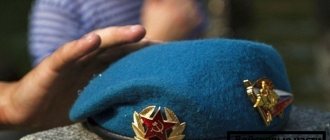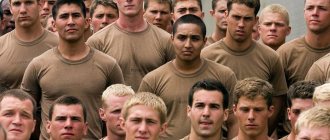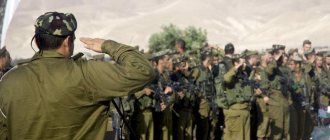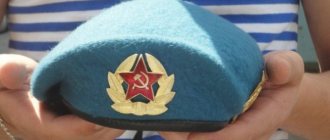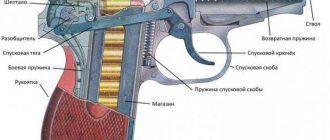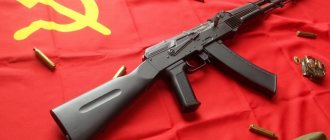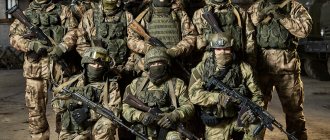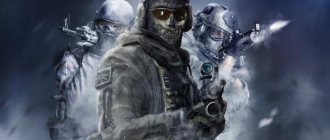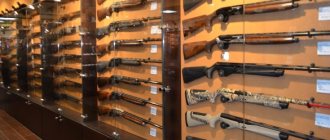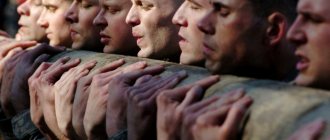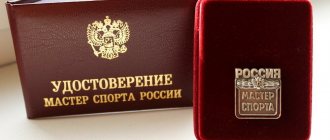For senior special forces soldiers, a special event is the veteran’s surrender to the maroon beret. The rules for the exam were developed by the famous commander of the Vityaz unit, Hero of the Russian Federation Sergei Lysyuk. Passing the standards is not easy even for a seasoned fighter, but men set a goal for themselves and those worthy receive a maroon beret.
The maroon color is a symbol of courage; it reflects the fact that the special forces soldier is a professional. It is worn by military personnel and SSN veterans who have earned this right. The tests are open to those who have been seriously injured during military operations and are unable to participate in the tests or take other exams. They pass these standards and confirm their high qualifications.
About the maroon beret
What special meaning does wearing a maroon beret have? Why is it red? As you know, military personnel of the airborne troops, as well as GRU special forces, wear sky-blue berets as their daily uniform. Recently, the right to wear the same berets has been reserved for Air Force personnel in some individual cases.
And if everything is clear with the airborne troops, then how can we explain the color of the beret in the case of the internal troops? But the fact is that the fighters of the elite units of the internal troops are trained really harshly. Veterans of the GRU special forces note that the hallmark of any intelligence officer and special forces soldier is the willingness to cover enormous distances at a fast pace. That is, excellent endurance, the ability to make forced marches while armed.
In fact, that's how it is. Currently, GRU units place more emphasis on endurance than strength training. Although this element is undoubtedly also present. But in the elite units of the internal troops this makes even more sense. The question arises: “Why?” The fact is that surrendering to a maroon beret means making a 12-kilometer forced march in full equipment. As they progress through this distance, fighters will be faced with the need to complete micro-tasks. This is not the only task that must be completed during the exam for the right to wear a maroon beret. However, without passing it, subsequent execution of the complex is impossible.
To the goal through pain
"Krapovik" must have exceptional knowledge and combat training skills. To test them, a number of tests are provided: theoretical tests, physical training, medical examination and, according to the fighters, the most difficult thing is a complex of testing professional skills. First, a ten-kilometer forced march over rough terrain in full equipment, and then, without a break, an obstacle course with simulated combat conditions - the soldiers must, even in a state of stress and critical situations, follow the orders of the commander and make the right decisions.
They live among us. Stories about those for whom heroism is an ordinary job Read more
“The forced march and the obstacle course were difficult for me. Many broke down during the shooting. Despite the fact that everyone can shoot, after an obstacle course and an assault on a high-rise building (according to the special operation scenario, there are hostages in the high-rise building, in order to free them, you have to attack from the roof) it is not easy to hit a small target. My hands are shaking, my anxiety is off the charts,” says Denis. - It's a competition with yourself. It’s hard, but you go towards your goal through pain and difficulties.”
Another test is hand-to-hand combat with the current owner of a maroon beret. There is a lot at stake - if the “krapovik” loses to the challenger, he will lose his beret and will have to overcome the tests all over again. So men fight like adults. Special forces say that the maroon beret is not a sporting achievement, it is fate.
Special forces: surrender for a maroon beret (standards)
Before a certain number of people are gathered to take the exam for the right to wear the maroon beret, all potential participants are tested for suitability. This is accomplished by passing physical fitness standards. The fighter’s rating on this point should not be lower than “good”. At the same time, fire, tactical, and special physical training are assessed. If it is below “excellent”, then the fighter will simply not be allowed to take the exam.
The tests to be taken by potential applicants for the right to wear a maroon beret include a 3-kilometer run, pull-ups on a horizontal bar, and a complex that includes 4 exercises. These are push-ups from the floor, the “squatting-lying emphasis” exercise, performing abdominal exercises, as well as jumping up from a squat. These exercises are performed in mode 7 to 10. You need to pass the preliminary test a couple of days before taking the main exam.
Preventing the appearance of bees in the house or country house
The following measures will help prevent the appearance of bees, as well as protect themselves from their repeated nesting:
Complete destruction of bee nests, honeycombs and all traces of their presence on the site. It is a well-known fact that if you leave a nest empty, a new colony will soon move into it.
It is important to get rid of odors; for spraying former sites, both special sprays and homemade mixtures based on citrus peels, essential oils (almond, wormwood) and herbal infusions (mint, lemon balm, wormwood) with a repellent effect are suitable. Vinegar can be used for the same purposes. Carrying out the necessary repairs is the next step
If, when removing the nest, you had to dismantle the floor, wall, or make a hole in the roof, you will have to do reconstruction. It is also important to inspect the house and all outbuildings for cracks and holes, which could theoretically become a new haven for lepidoptera. It is better to fill the holes with bee-resistant materials - insulating foam, cement, steel wool, etc. Painting all wooden elements will serve as additional insurance - insects will avoid paint. All trees (and even logs) on the site must be inspected for breaks, cracks and hollows. You may have to get rid of some of them. Large cracks in the ground and burrows made by rodents should also be isolated. You should not allow garbage to accumulate, leave old furniture in the yard for a long time, and keep the compost pit open.
Whether to destroy bees or not is a private question; it is important to weigh the risk and benefit of such a neighborhood. Of course, the best option is to contact professional exterminators, beekeepers, and consult
If this is not possible, then rushing into battle without prior preparation is a dangerous idea, because hundreds and even thousands of insects can simultaneously live in a nest. An attack by so many bees could simply end in tragedy.
Purpose of testing
The purpose of the qualification tests is to select the most trained military personnel who have advanced individual physical and fire skills. Such officers are very valuable due to their use in apprehending particularly dangerous criminals. When conducting tests, moral qualities are also developed.
As mentioned earlier, the basis of surrender is completing a forced march. Each fighter puts on all equipment, including military uniform, body armor, and helmet. At the same time, the military personnel perform a forced march along with their service weapons. It is at this stage of the competition that a larger number of potential candidates are eliminated. In general, the length of the forced march is 12 kilometers. But if not enough applicants are eliminated at the stage, the distance is increased until the required number of fighters remains.
A forced march involves more than just running over rough terrain. This is running uphill and downhill, crossing swamps and even rivers, carrying a friend, crawling, and so on. Immediately after completing the forced march, the fighters proceed to pass the fire-assault obstacle course. Upon completion, a shot is fired from the service weapon to check the condition of the weapon. If it does not work, the participant will be disqualified.
The next test is shooting. This, of course, is performed against the background of severe fatigue, which significantly affects accuracy. Here the additional skills of the fighters are tested. After passing the shooting ranges, the military personnel begin to storm the 5-story building. Using special equipment, they must descend from the roof, while simultaneously opening fire on targets that replace the potential enemy. At the same time, you cannot hit a target simulating a hostage. After landing, the cables are unfastened, the serviceman must run to the radio station standing on the table and report the completion of the assault.
Tests
Presentation of the beret
Forced march
Overcoming water obstacles
Special assault strip
Training match
Purpose of testing
:
- Identify military personnel with the highest individual training for actions to neutralize armed criminals, free hostages and perform other tasks in critical situations and emergency circumstances;
- Creating an incentive to cultivate high moral qualities in military personnel.
Preliminary
The preliminary stage of testing is the final inspection during the training period for the special forces unit program. The overall assessment for the inspection should be no lower than “good”, and for special fire, special physical and tactical training of internal troops - “excellent”. Testing includes: running 3 thousand meters; pull-up (according to NFP-87); a set of strength exercises - 4x10 (push-ups, squat-press, abdominal exercise, jumping from a squat position) is carried out in seven repetitions. Testing is carried out 1-2 days before qualification tests.
Basic
The main tests are carried out in one day and include a forced march of at least 10 km, followed by overcoming obstacles SOP (special obstacle course) in extreme conditions, inspection of training for storming high-rise buildings, acrobatics and hand-to-hand combat.
- 12-kilometer forced march.
- Passing a special obstacle course - overcome on the move after completing the march. After passing through the OSP (fire-assault zone), in order to inspect the condition of the weapon during the forced march and overcoming obstacles, one blank shot is fired from a service weapon.
- Examination of high-speed shooting skills against a background of fatigue. Trainees immediately after inspecting the functionality of the weapon move to the firing line to perform 1 SUUS (special firing training exercise) from a machine gun. The exercise time is 20 seconds.
- The examination of skills in storming high-rise buildings using special descent equipment is carried out on a five-story building. The exercise time at this stage is 45 seconds. Those who do not meet this deadline will not be allowed to participate in subsequent tests.
- Performing acrobatic exercises: kip-up from a supine position; kicking a silhouette followed by a somersault; forward somersault from an acrobatic springboard or swing bridge.
- Performing 4 hand-to-hand combat complexes.
- Training matches (of special importance) - the fight is conducted for 12 minutes without a break with a change of three partners, one of whom is the same examinee, the others are military personnel who already have a maroon beret. In the case of a passive duel between subjects, they are “broken” for one minute, and the duel with each of them is conducted by observers who will participate in the tests of the next subjects. If the subjects continue to show passivity, the “breaking” is repeated.
Note: the subject is allowed to provide medical assistance on the site for no more than 1 minute during the fight.
Peculiarities
- If there are three comments, the serviceman is removed from further testing.
- It is impossible for all participants to pass the test. Only 20-30% of those taking part reach the second and third tests.
- Instructors are strictly prohibited from providing assistance to subjects during the march and overcoming obstacles, as well as from interfering in the testing process or issuing any commands or orders to help the participant.
- The doctor's decision during testing is the most important thing.
- Since 2009, the standard for “high altitude” was not 45 seconds, but 30 seconds. Taking into account the fact that the subject must run 15 meters away from the building that he stormed and put the “eight” on the table or hit the table with his palm.
- After performing acrobatic elements, the subjects show sets of special exercises: three sets of hand-to-hand combat and one with a weapon.
Acrobatics and grappling
This is followed by a set of acrobatic exercises, which include a wall somersault with a turn, a forward somersault from a springboard, and a kip-up.
And finally, the decisive stage. This is the most difficult part of the test. In general, she decides which fighter will receive the honor of wearing a maroon beret. This is nothing more than a test of the endurance and strong-willed qualities of a soldier through continuous hand-to-hand combat.
The examinee who reaches this part will have to fight for 12 minutes. Fights last 4 minutes. During hand-to-hand combat, the fighter will fight with one more examinee, and the remaining two opponents will already be owners of a maroon beret. This is the most difficult stage, if only because the special forces soldier is already on the verge of exhaustion. And his opponents (owners of a maroon beret) are full of strength. In general, during a hand-to-hand fight, the most important thing for a soldier is not to get knocked out. Here warnings are counted for passive conduct of a duel, but this is if the soldier does nothing at all. During the fight, the fighters receive cuts and bruises, but the beret is maroon because it shows the color of the blood paid to receive it.
After what exams can you wear a black beret?
A fighter receives the privilege of wearing a black beret after successfully passing the exam. Most often, such an exam is strictly standardized. However, minor adjustments may be made to its organization. The stages can change order; in different units, fighters perform physical standards in different conditions.
Presentation of the black beret
The honorary award is usually presented by the unit commander. The warrior receives the well-deserved regalia from the hands of a superior officer, takes a knee, and says “I serve the Fatherland!” and kisses and takes.
If you want to buy a personal black beret, you can purchase it from our partners:
GRU special forces beret
The beret as a headdress for military personnel appeared in the mid-20th century. The first berets were crimson in color and were worn by soldiers and officers of the airborne troops of the USSR Ministry of Defense. Later, blue was chosen as the color of the sky. Passing the exam for the Blue Beret of the Airborne Forces is much easier than for GRU special forces.
GRU special forces beret
The maroon beret appeared as a distinctive symbol of special forces in 1978. At that time, the USSR was preparing to host the Olympic Games, which, as is known, were to take place in 1980 in Moscow.
Taking into account the sad experience in Munich in 1972, the task was set to ensure a high level of security at international competitions.
About the maroon beret of the GRU special forces
On the basis of the 9th company of the Special Forces of the 3rd battalion of the 2nd regiment of the Hotel Motorized Rifle Division named after. F.E. Dzerzhinsky (OMSDON) a special purpose training company was created. The maroon color of the headdress was not chosen by chance: on the one hand, the color of dried blood, and on the other, the color of the shoulder straps of soldiers of the USSR Ministry of Internal Affairs. That is why the first 25 berets had this color.
Sergeant Georgy Stolbusenko is the first soldier to receive the maroon beret of the GRU special forces.
URSN commander Sergei Lysyuk and ZKR for special training Viktor Putilov became the founders of a new tradition.
The book "Alpha Team" made a strong impression on them. The author (Miklos Szabo, a former Green Beret of the US Marine Corps) talked about the process of training and education in the US special forces. In addition, the book described the exam for the right to wear a green beret. The grueling tests are reflected in the new exam.
The right to wear it can be obtained after passing a special exam. In addition, the maroon beret can be awarded for courage in performing service and combat missions and for services in the development of special forces units of the VNG of the Russian Federation (Rosguard), the Ministry of Internal Affairs and the Federal Penitentiary Service.
Purpose of the exam
An examination for the right to wear a maroon beret is held at the end of each training period. According to the plan, military personnel of special units improve their professional level during combat training classes. The most prepared of them become candidates for the maroon beret exam, the standards of which not every test participant can meet.
Objectives of qualification tests
- identify the most trained military personnel who are able to act in case of sudden changes in the situation;
- increase the level of professional training of special forces units;
- improving stress tolerance, developing high strong-willed qualities and creating an incentive for the growth of business qualities.
To get the right to take the exam, you need to prove yourself on the positive side. Each special forces detachment has a council of maroon berets, whose members know what a special forces soldier should be like. The tasks of the council include making a decision on each candidate who decides to join the elite unit.
Deprivation of the insignia
This measure is applied to fighters who, for some reason, were unable to maintain this privilege. This right can be deprived for various reasons. It is much easier to lose this right than to acquire it. The maroon beret may be deprived in cases where a fighter shows cowardice during hostilities or his actions led to the death of a comrade through his fault.
In addition, poor physical fitness, negligence, violation of discipline and the use of special training skills for selfish purposes can lead to the loss of this right. Such a decision can only be made in the council of maroon berets, based on a complaint received from the commander of the unit where the soldier serves.
Find out: What kind of shoulder straps do Russian marshals wear, what do they look like?
After the service period was reduced to one year, only military personnel serving under a contract are allowed to take such tests. This insignia does not provide any special privileges in relation to other fighters. Does not entitle you to receive increased pay or special treatment in terms of promotion.
But every fighter who was honored to wear this insignia on his head can say how important this attribute of clothing is for him personally. It may lose color and look different immediately after being awarded, but it is not just a piece of uniform, it is the award that every special forces soldier strives for.
Author's rating
Author of the article
Vitaly Ryabov
I have conscription service behind me, and then contract service. Now retired.
Articles written
241
Standards for maroon beret
Surrendering a beret consists of several stages:
- passing standards for physical training;
- forced march with the passage of a fire-assault line;
- training matches according to the rules of hand-to-hand combat. Each standard for passing the maroon beret must be met in accordance with the requirements of the manual on physical training in the Internal Troops of the Ministry of Internal Affairs of the Russian Federation dated 2005. Only the strongest candidates can undertake this task. Even the standards for the black beret, which are passed by marines, are considered much softer compared to those approved for GRU special forces.
- Pull-ups on the bar - 15 times;
Pull-up on the bar
- Running 3 km - 12 min 10 sec;
- 100 m run - 13.6 sec;
- Cooper test - 7 laps in 10 minutes.
Do not confuse this test with the running exercise of the same name. One circle includes 10 push-ups with fists, 10 times bringing the legs to the chest, 10 times press, 10 jumps (“Spreader”, “Marine Corps”).
Therefore, over the last 1-2 years, complex strength exercises on the horizontal bar have been added to the standards for the maroon beret.
It is necessary to perform 7 circles, each of which includes an inversion on the bar, a pull-up, a power-up and a leg lift. The exercises are performed once and in the same sequence.
If at least one standard of the exam for the maroon beret is not met, then further participation in the selection is not allowed. Before taking the maroon beret test in Russia, each candidate is required to undergo powerful, exhausting physical training.
How to pass a maroon beret in Russia
The change for the maroon beret usually starts at 6 am. The equipment of each candidate is the same: uniform for the season, body armor (at least 10 kg), helmet, gas mask, machine gun. During the surrender, the loss of any element of equipment is not allowed. Each person also receives one blank cartridge.
See also the article Uniform of the Russian Navy
All tests take place on one day, one after another:
- 10 km forced march;
- passing the fire-assault line;
- assault on a high-rise building;
- performing special shooting exercises;
- acrobatics;
- display of hand-to-hand combat complexes (3 without weapons and 1 with weapons);
- hand-to-hand combat.
Forced march
At the appointed time, all candidates line up on the parade ground, and the senior commander gives the order for the march. Immediately after the start, a very high pace is set in order to remove as many participants as possible. It lasts for 2-2.5 km. After this, candidates enter a smoke-filled area and use gas masks, in which they continue the test for some time.
Wearing a gas mask during an exam
In addition, various commands are given during the march:
- being ambushed;
- overcoming water obstacles, rubble, natural obstacles, etc.;
- enemy air attack;
- evacuation of the wounded;
- push-ups and bringing your legs to your chest.
After 2 hours, the forced march ends and the passage of a special obstacle course begins.
Overcoming the obstacle course
Instructors are not allowed to help and anyone who is more than 50 m behind the main group is disqualified from the test.
Passing an individual WBS element
During the passage of checkpoints, smoke bombs, simulated explosion packages, and shelling with blank cartridges are widely used. Here, candidates act as part of fighting trios, and the failure of one can lead to the removal of the entire group. Therefore, special attention is paid to coherence and mutual assistance.
How are these tests carried out?
The tests have two purposes:
- They are designed to identify specially trained special forces soldiers who are capable of freeing hostages under special conditions and neutralizing dangerous criminals.
- Another goal is motivational, creating an incentive for the entire special forces unit.
Not everyone is allowed to take such tests; military personnel who joined the army and served for at least six months under a contract or conscription in special forces units of the internal troops have this right.
The qualification tests have 2 stages, over 2 days. On the first day, applicants take tests in fire training, tactics, and also take those disciplines that were studied during training in special forces training courses. If the applicant passes this stage and receives a grade of at least “good”, he is admitted to the second stage. In addition, at the preliminary stage you must pass a physical fitness test.
The tests include a forced march of 3 kilometers, pull-ups and other exercises included in the program. After passing the preliminary exams, those who pass this stage and receive a grade of at least “excellent” are admitted to the main stage. In each discipline, they can be removed from the test for poor performance, so not everyone is allowed to the second stage.
The main stage includes:
- A forced march through difficult terrain with a length of about 10 kilometers.
- A complicated obstacle course.
- Shooting training.
- Test for the ability to storm multi-story buildings.
- Testing for acrobatic skills.
- Hand-to-hand combat.
While undergoing testing, fighters are subjected not only to enormous physical stress, but also to great psychological pressure. During the forced march stage, subjects are given additional commands. What are these commands? The commander conducting the test can give a command about a surprise attack by the enemy or create a simulation of passing through a zone with toxic substances.
In addition, overcoming obstacles with water and mud or evacuating the wounded only adds to the complexity. The time allotted for completing this test is determined according to weather conditions and terrain features. Fighters who do not meet the allotted time are not allowed to participate in further tests.
Find out: What kind of shoulder straps do military school cadets wear?
An equally difficult stage is the obstacle course. At this stage, special observation of the subjects is established. For every 5 people, 1 instructor is allocated, since there are frequent cases of injury at this stage.
Psychological pressure is exerted by sound effects simulating explosions and gunshots. Part of the strip is filled with smoke to create special conditions close to real combat operations. It is not for nothing that the special forces motto sounds like “Special forces are like iron, without action they rust.” There are a lot of these actions during testing.
The subsequent stages are just as difficult. The final stage, where hand-to-hand combat skills are tested, is carried out in special equipment. Wearing a protective helmet and boxing gloves, but even despite such protection, there are frequent cases of knocked out teeth and broken noses among the test subjects. However, for those who have passed all the tests with honor, all the difficulties of passing the tests become unimportant when they are awarded the insignia received in such a difficult struggle.
The presentation of the maroon beret takes place in a solemn atmosphere and in front of his colleagues, the fighter receives this award. At such a moment, emotions overwhelm everyone who with such difficulty won the right to wear this insignia. The soldier is given a beret and with the words: “I serve the fatherland and special forces!”, He becomes one of those who has the privilege of wearing this headdress of a special color.
Verification of candidates
After the reorganization of the Internal Troops of the Ministry of Internal Affairs of the Russian Federation into the Russian Guard, OMON and SOBR officers are also allowed to take the exam. In each special forces detachment, internal selection is carried out among all comers.
Typically, selection consists of passing standards and completing a forced march. After this, the one who has received admission, as part of a separate group, prepares according to a special program to pass the main test, which is based on passing the exam for the blue beret of the Airborne Forces. They study the features of exercises, increase endurance and strength.
Where is the exam held?
The exam is held 2 times a year (April-May and September-October):
- in Smolensk on the basis of OSPN "Mercury";
- in Novosibirsk on the basis of the Iskitim Training Center;
- in the Krasnodar region in the 8th mountain training center “Hatsavita”;
- in Khabarovsk on the basis of OSPN "Typhoon";
- in the Leningrad region on the basis of the Kirovsky training center;
- in the Sverdlovsk region on the basis of OSPN "Ural".
Over the years, tests took place in the city of Grozny on the basis of the Severny training center (34 OSPN) and in the city of Novocherkassk, Rostov region (10 training centers, 7 Rosich OSPN).
Particular attention is paid to the fighter’s outlook, intelligence and mental abilities. In addition to knowledge of theory (characteristics of weapons, rules of medical care, etc.), they can test knowledge of the history and structure of the state.
Additional requirements
The fire training stage has also undergone changes. The exercise has become more complex and includes:
- hitting moving and emerging targets from a machine gun at a distance of 25 to 100 meters;
- defeat with a pistol after crawling 50 meters (the target is a moving enemy patrol at a distance of 10 meters);
- installation of anti-personnel MON-50 and withdrawal to the starting line.
When passing the maroon beret, some instructors help their colleagues, which, of course, is prohibited. For example, running is deliberately set at a slow pace or shooting results are not assessed so strictly.
In addition, there are cases when “krapoviki” deliberately do not allow military personnel to take part in the test or remove them from the Master of Masters or Masters of Masters in martial arts. An athlete can simply win a hand-to-hand fight with an instructor, and then the latter should be deprived of his maroon beret.
Veteran's change for a maroon beret
Those who previously served in special forces, but for some reason were unable to meet the standards for passing for a maroon beret, can obtain this right at the veteran's passing, which takes place once a year at the Vityaz training center in the Moscow region.
After confirming his involvement in service in special forces (certificate of service, mark on a military ID, etc.), the person wishing to do so is included in the list of participants. After a week-long training camp at the training center, the exam itself begins.
The conditions are a little easier than those that exist for active specialists. However, the loads are still simply prohibitive.
The cost of fees is 10,000 rubles. The price includes a week of accommodation, preparation for the exam program, 2 sets of uniforms (for training and for passing) and a T-shirt with the symbols of the Special Forces.
Information about the veteran's surrender day can be published on the Internet on the website of the veteran organization SSN.
Maroon beret: the highest insignia of Russian special forces
In Russia, the maroon beret is not just an integral part of the military uniform, marking their belonging to certain military formations. Since Soviet times, this headdress has been considered one of the most honorable insignia, emphasizing that its owner belongs to elite units, and the right to wear it is achieved only by passing the most difficult tests, which not everyone can successfully pass.
The very concept of “speckled color” is often directly associated with the idea of “sprinkled with blood,” but this is not at all the case. The reason for the difficulties in interpretation was the very outdated origin of the word - from the German Krapp, denoting a perennial herbaceous plant widespread in temperate climates, known in Russia as “dying madder”. In the 19th century, the powerful roots of madder became the basis for obtaining a persistent natural dye of bright red tones. Subsequently, crappie as a dye became primarily associated with a purplish-red hue.
History of the domestic maroon beret
Due to their practicality, berets have become widespread as an element of army and police uniforms in many countries in Europe and America since the end of the 19th century. But in the Russian Empire this type of headdress did not become widespread, and in the USSR only from the late 1930s it began to be used in the uniform of female military personnel. Only in the post-war years, under the influence of information about the appearance of the “probable enemy”, did the introduction of berets begin as a distinctive element of the uniform of some special forces - the Marine Corps, and then the airborne troops.
At the same time, the Soviet military command firmly established the most important principle: the right to wear berets was positioned as exclusive and was given only to special troops who performed the most difficult and dangerous work. Since the second half of the 1960s, the military beret in the USSR has become an elite symbol, confirming the strength and skills of its wearer.
In the Internal Troops of the USSR Ministry of Internal Affairs, the appearance of the beret is associated with the formation of their own elite special forces on the eve of the Moscow Olympics. The first of the special forces in the structure of the Internal Troops who were allowed to wear berets as a special distinctive symbol were the servicemen of the 9th Special Purpose Training Company (URSN) of the 3rd Battalion of the 2nd Regiment OMSDON (“Dzerzhinsky Division”) created in 1978. The author of this proposal is considered to be Lieutenant General A.G., who held the post of chief of combat training at that time. Sidorov.
The choice of the maroon color of the beret is associated with its traditional correspondence with the colors of the distinctive signs of the uniform of the Ministry of Internal Affairs, which in turn originate from the color of the stars on the headdresses of the Workers' and Peasants' Militia of the RSFSR, first officially approved back in 1920.
For some time, the maroon beret was the same insignia as berets of other colors for the Marine Corps and Airborne Forces, but in January 1988, the command of the Vityaz special forces detachment put forward the initiative to make a headdress of this particular color the privilege of only those fighters who could show their professional and moral qualities in the process of passing special tests.
It is believed that this idea was borrowed from the description of the training process of the American Green Berets, although the most similar principles of passing a complex of very difficult tests for modern fighters of elite units, with the subsequent awarding of special insignia to those who successfully passed the exam, were first developed during the Second World War, when creating the British SAS (Special Air Service - “Special Air Service”).
Similar tests in the Soviet and then Russian Vityaz were unofficial for a long time and were carried out under the guise of comprehensive control exercises. The wearing of a maroon beret by the select few did not find understanding among the command, according to which all military personnel should wear the insignia, regardless of their level of training. The situation changed in May 1993, when the commander of the internal troops at that time, A.S. Kulikov (later the Minister of Internal Affairs of the Russian Federation in 1995-1998) approved the regulation “On qualification tests of military personnel for the right to wear the Maroon beret.”
This document legalized and regulated the passing of test exams for the right to wear a maroon beret, but at the end of the 1990s, a significant decrease in the value of this insignia began to occur. The issuance of maroon berets has become widely practiced in local special forces units within the structure of the Internal Troops of the Ministry of Internal Affairs of the Russian Federation. Various riot police and special forces began to organize an exam for the right to wear a maroon beret directly in their unit, while significantly softening the conditions for passing it.
It was possible to return to a situation in which the highest symbol of special forces would again mean passing the most difficult test only in 2008, with the advent of the order of the Ministry of Internal Affairs of the Russian Federation “On the procedure for passing qualification tests for the right to wear a maroon beret.” This document streamlined the process of passing the test exam, the essence of which has generally been preserved to this day.
The right to wear a maroon beret is also awarded to military personnel of special forces units and units who participated in hostilities and received serious wounds and injuries that do not allow them to fulfill the standards of the exam for the right to wear this insignia.
